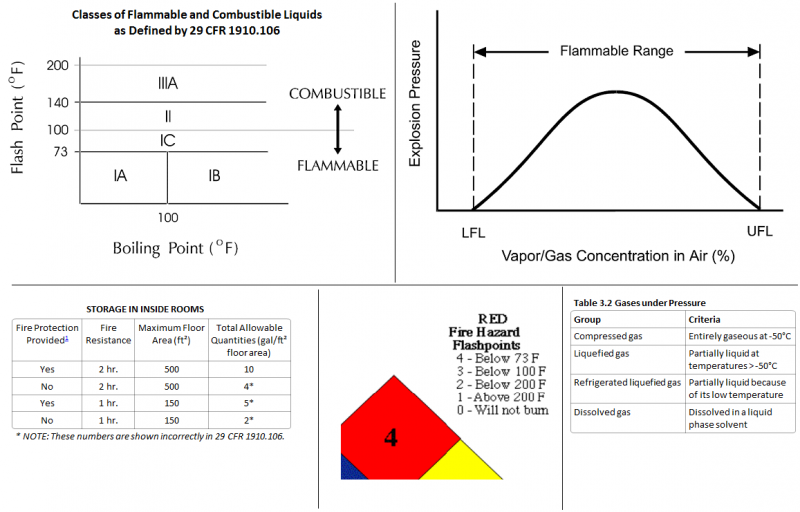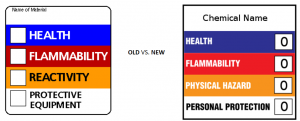Hazardous Chemicals
Flammability
<figure-inline> </figure-inline>
</figure-inline>
Storage in Inside Rooms
| Fire Protection
Provided[1] |
Fire
Resistance |
Maximum Floor
Area (ft²) |
Total Allowable
Quantities (gal/ft² floor area) |
|---|---|---|---|
| Yes | 2 hr. | 500 | 10 |
| No | 2 hr. | 500 | 4* |
| Yes | 1 hr. | 150 | 5* |
| No | 1 hr. | 150 | 2* |
* NOTE: These numbers are shown incorrectly in 29 CFR 1910.106.
Gases
| Group | Criteria |
|---|---|
| Compressed gas | Entirely gaseous at -50°C |
| Liquefied gas | Partially liquid at temperatures > -50°C |
| Refrigerated liquefied gas | Partially liquid because of its low temperature |
| Dissolved gas | Dissolved in a liquid phase solvent |
Pasted from http://www.osha.gov/dsg/hazcom/ghs.html
HMIS (Hazardous Material Identification System)
Blue/Health
The Health section conveys the health hazards of the material. In the latest version of HMIS, the blue Health bar has two spaces, one for an asterisk and one for a numeric hazard rating. If present, the asterisk signifies a chronic health hazard, meaning that long-term exposure to the material could cause a health problem such as emphysema or kidney damage. According to NPCA, the numeric hazard assessment procedure differs from that used by NFPA.
4. Life-threatening, major or permanent damage may result from single or repeated overexposures (e.g., hydrogen cyanide).
3. Major injury likely unless prompt action is taken and medical treatment is given.
2. Temporary or minor injury may occur.
1. Irritation or minor reversible injury possible.
0. No significant risk to health.
Red/Flammability
For HMIS I and II, the criteria used to assign numeric values (0 = low hazard to 4 = high hazard) are identical to those used by NFPA. In other words, in this category, the systems are identical. For HMIS III, the flammability criteria are defined according to OSHA standards.
4. Flammable gases, or very volatile flammable liquids with flash points below 73 °F (23 °C), and boiling points below 100 °F (38 °C). Materials may ignite spontaneously with air (e.g., Propane).
3. Materials capable of ignition under almost all normal temperature conditions. Includes flammable liquids with flash points below 73 °F (23 °C) and boiling points above 100 °F (38 °C), as well as liquids with flash points between 73 °F and 100 °F.
2. Materials which must be moderately heated or exposed to high ambient temperatures before ignition will occur. Includes liquids having a flash point at or above 100 °F (38 °C) but below 200 °F (93 °C) (e.g., Diesel fuel).
1. Materials that must be preheated before ignition will occur. Includes liquids, solids and semi solids having a flash point above 200 °F (e.g., Canola oil).
0. Materials that will not burn (e.g., Water).
Yellow/Physical Hazard
Reactivity hazard are assessed using the OSHA criterion of physical hazard. Seven such hazard classes are recognized: Water Reactives, Organic Peroxides, Explosives, Compressed gases, Pyrophoric materials, Oxidizers, and Unstable Reactives.
4. Materials that are readily capable of explosive water reaction, detonation or explosive decomposition, polymerization, or self-reaction at normal temperature and pressure
3. Materials that may form explosive mixtures with water and are capable of detonation or explosive reaction in the presence of a strong initiating source. Materials may polymerize, decompose, self-react, or undergo other chemical change at normal temperature and pressure with moderate risk of explosion.
2. Materials that are unstable and may undergo violent chemical changes at normal temperature and pressure with low risk for explosion. Materials may react violently with water or form peroxides upon exposure to air.
1. Materials that are normally stable but can become unstable (self-react) at high temperatures and pressures. Materials may react non-violently with water or undergo hazardous polymerization in the absence of inhibitors.
0. Materials that are normally stable, even under fire conditions, and will not react with water, polymerize, decompose, condense, or self-react. Non-explosives.
White/Personal Protection
This is by far the largest area of difference between the NFPA and HMIS systems. In the NFPA system, the white area is used to convey special hazards whereas HMIS uses the white section to indicate what personal protective equipment (PPE) should be used when working with the material. A guide is located here, 
Pasted from http://en.wikipedia.org/wiki/HMIS_Color_Bar
Volatility
Brainstorming
Globally Harmonized System of Classification
While the existing laws and regulations are similar, they are different enough to require multiple labels for the same product both within the U.S. and in international trade and to require multiple safety data sheets for the same product in international trade. Several U.S. regulatory agencies and various countries have different requirements for hazard definitions as well as for information to be included on labels or material safety data sheets. Pasted from <http://www.osha.gov/dsg/hazcom/ghs.html>
The Hazard Communication Standard (HCS) also requires training for employees exposed or potentially exposed to hazardous chemicals. The Hazard Communication Standard does not, however, cover hazardous wastes as defined and regulated by the EPA. For other hazardous chemicals known to be present at the workplace, the standard states that health hazard information is required to be transmitted from the chemical manufacturer or importer and flow "downstream" with the substance as it is used by industry. Pasted from <http://www.osha.gov/pls/oshaweb/owadisp.show_document?p_table=INTERPRETATIONS&p_id=20295>
6. Health Effects of Toxic Chemicals
There are many materials used in the workplace that can be hazardous. However, in order for them to affect your health, they must contact the body or be absorbed into the body. When assessing the potential health effects from working with a particular material it is necessary to understand difference between "toxicity" and "hazard".
1. TOXICITY is the ability of a substance to produce an unwanted effect when the chemical has reached a sufficient concentration at a certain site in the body.
The more toxic a material is, the smaller the amount of it necessary to be absorbed before harmful effects are caused. The lower the toxicity, the greater the quantity of it necessary to be absorbed. The toxicity of a chemical is generally measured by experiments on animals (quite often rats). If it is measured in terms of the amounts of material necessary to cause death in 50% of the test animals. These values are called LD50 (lethal dose) or LC50 (lethal concentration), and are usually given in weight of material per kg of body weight or airborne concentration of material per set time period respectively.
2. HAZARD is the probability that this concentration in the body will occur.
Toxicity is an inherent property of the material. A material may be very toxic, but not hazardous, if it is handled properly and is not absorbed into the body. On the other hand, a material may have a very low toxicity, but be very hazardous.
Example:
1. An open container of an acid is much more hazardous than a closed container of the same material.
2. Two liquids may possess the same degree of toxicity but present different degrees of hazard:-
One material may be non-irritating to the eyes and nose and odourless. The other may be irritating to the eyes or respiratory system and possess a pungent odour.
The latter material, because of its warning properties presents a lesser degree of hazard.
In order for toxicants to affect the human system either they must cause damage to external tissues, such as the skin or eyes, or they must be able to enter the body by some mechanism.
Pasted from <http://www.ehs.utoronto.ca/resources/whmis/whmis6.htm>
Physiological Classification of Materials
This classification identifies toxic materials on the basis of biologic action.
Irritants - refers to some sort of aggravation of whatever tissue the material comes in contact with.
e.g. ammonia, nitrogen dioxide.
Asphyxiants - exert their effects through a depletion of oxygen to the tissues
e.g. - simple asphyxiants - carbon dioxide, nitrogen, methane, hydrogen
chemical asphyxiants - carbon monoxide, hydrogen cyanide, hydrogen sulphide.
Narcotics or Anaesthetics - the main toxic action is the depressant effect upon the Central Nervous System.
e.g. - many organics, chloroform, xylene.
Systemic Poisons - the main toxic action includes the production of internal damage
e.g. Hepatotoxic agents - toxic effects produce liver damage. eg. carbon tetrachloride.
e.g. Nephrotoxic agents - toxic effects produce kidney damage eg. some halogenated hydrocarbons
Carcinogens - agents/compounds that will induce cancer in humans.
e.g. benzene, arsenic, inorganic salts of chromium, nickel, beryllium.
Mutagens - agents that affect the cells of the exposed people in such a way that it may cause cancer in the exposed individiual or an undesirable mutation to occur in some later generation.
e.g. radiation, variety of chemical agents that alter the genetic message.
Teratogens - Agents or compounds that a pregnant woman takes into her body that generate defects in the fetus
e.g. Thalidomide, possibly steroids
Sensitizers-Agents that may cause allergic or allergic-like responses to occur. After an initial exposure to a substance an individual may become sensitized to that substance. Subsequent exposures to the same substance, often at a much lower concentration than before, produce an allergic response. This response may be a skin rash (dermatitis) or an asthmatic-like attack, depending on the route of exposure.
e.g. cutting oils, isocyanates in polyurethane foam operations and paint spraying operations, some laboratory solvents.
Pasted from <http://www.ehs.utoronto.ca/resources/whmis/whmis6.htm>
TOXICOLOGY AND EXPOSURE GUIDELINES
http://ehs.unl.edu/chemicalinfo/tox_exposure_guidelines.pdf
Dose-Response Terms. The National Institute for Occupati onal Safety and Health (NIOSH) defines a number of general dos e-response terms in the "Registr y of Toxic Substances" (1983, p.xxxii). A summary of these terms is contained in Table 1.
• Toxic dose low (TDLO) : The lowest dose of a substance introduced by any route, other than inhalation, over any given period of time, and reported to produce any toxic effect in humans or to produce tumorigenic or reproductive effects in animals.
• Toxic concentration low (TCLO) : The lowest concentration of a substance in air to which humans or animals have been exposed for any given period of time that has produced any toxic effect in humans or produced tumorigenic or reproductive effects in animals.
• Lethal dose low (LDLO) : The lowest dose, other than LD50 of a substance introduced by any route, other than inhalation, which has b een reported to have caused death in humans or animals.
• Lethal dose fifty (LD 50): A calculated dose of a substance which is expected to cause the death of 50 percent of an entire defined expe rimental animal populati on. It is determined from the exposure to the substance by any route other than inhalation.
• Lethal concentration low (LCLO) : The lowest concentration of a substance in air, other than LC50, which has been report ed to cause death in humans or animals.
• Lethal concentration fifty (LC 50): A calculated concentration of a substance in air, exposure to which for a specified length of time is expected to cause the death of 50 percent of an entire defined experimental animal population.
Note to Self: Continue review at page 7 of this PDF.
